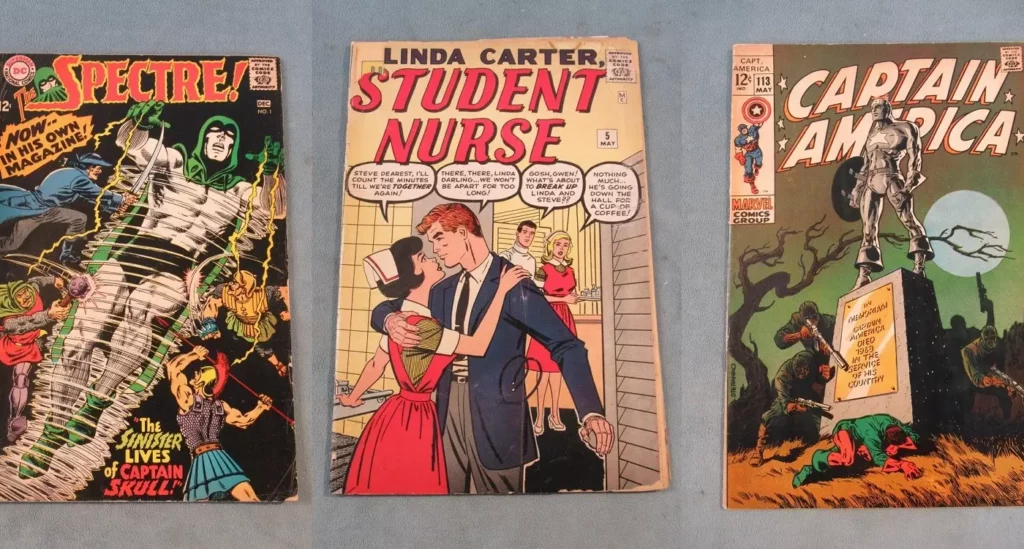The article will examine the various comic book defects that can affect comic book values. It will discuss which types of damage, such as creases, tears, water damage, or discoloration, have the most significant impact on the overall value of a comic book. Additionally, the article may provide tips on how collectors can identify and mitigate damage to preserve the value of their comic book collections. In case of resale, mitigating damage is very important, as it affects not just the look and sometimes readability of your comics, but also their value.
Typical Defects & Flaws
Comic books can suffer from a range of typical defects and flaws that affect their condition and, as a result, their value. Common issues include creases, tears, and folds, which can mar both covers and pages. Other defects might involve spine stress, color fading, and the presence of marks or stamps. Water damage is another serious concern, leading to warping and mold. Comics might also suffer from missing pages or cut-outs, significantly detracting from their appeal. Damaged comics can lose a significant portion of their value, as condition plays an important role in determining their worth to collectors and enthusiasts.
COLOR LOSS
Color loss on a comic book’s cover refers to the reduced color saturation affecting parts of the artwork. This issue can significantly impact the visual appeal and value of a comic. Color loss often results from exposure to sunlight or harsh lighting, which fades the ink over time. To mitigate this type of damage, store comics away from direct light sources. Protective sleeves that block UV rays can also help preserve the vibrant colors of your comics. Moreover, keeping comics in a controlled environment, where temperature and humidity levels are stable, can prevent further deterioration.
MISSING OR INCOMPLETE PAGES
Missing or incomplete pages in a comic book significantly affect its readability and value. This damage type includes pages that are torn, destroyed, or otherwise removed, disrupting the story and diminishing the collector’s item’s worth. To prevent such damage, handle comics with care, especially when reading or moving them. Use archival-quality bags with acid-free boards to provide support and reduce the risk of tearing. Store comics in a cool, dry place to avoid environmental damage that can lead to pages sticking together or becoming brittle and more prone to tearing. Additionally, keeping comics out of reach from children and pets can further protect them from accidental damage.
FADING
Fading refers to the overall reduced color saturation of a comic book’s cover, typically resulting from sun damage. This type of color loss affects the entire cover, leading to a diminished appearance and reducing the comic’s look and monetary value. Fading is primarily caused by prolonged exposure to sunlight or bright artificial light, which breaks down the ink colors over time.
To mitigate fading, store comics away from direct and indirect light sources. Using protective sleeves that offer UV protection can also protect your comics from harmful rays, preserving their colors. Maintaining comics in a controlled environment where light exposure is minimal may also work. For collectors looking to display their comics, choosing areas with low light or using UV-filtering frames can help prevent fading and keep the comics looking good.

FOXING
Comic book foxing is a type of damage seen as discolored spots on the paper of comic books, resulting from bacterial or fungal growth. These spots can range in color from light brown to reddish-brown, often giving the paper an aged or stained appearance. Foxing not only detracts from the visual appeal of a comic but can also indicate potential paper degradation.
To mitigate foxing:
- Maintain Low Humidity. Keep storage areas at low humidity levels, as moisture helps fungal growth.
- Proper Ventilation. Ensure that your storage area is well-ventilated to reduce the risk of moisture buildup.
- Use Acid-Free Materials. Store comics in acid-free bags and boards to minimize harmful chemical interactions with the paper.
- Avoid Direct Contact with Walls and Floors. Keep storage boxes off direct contact with walls and floors, especially in basements, to prevent moisture absorption.
- Regular Inspections. Check your comics every now and then for early signs of foxing.
By following these steps, collectors can significantly reduce the risk of foxing.
RUSTY STAPLE
Rusty staples are a common problem in older comic books, where the metal staples that bind the pages together start to rust. This rust not only weakens the comic’s binding but can also stain the surrounding paper, leaving unsightly marks that diminish the value and appeal of the comic. The main reason for rusty staples is moisture, which accelerates the rusting process. To prevent this, it’s important to store comics in a dry environment with controlled humidity levels. Using dehumidifiers in storage areas can also help. Protective comic book sleeves also have their role, as they protect comics from the environment, reducing the risk of moisture exposure.
YELLOWING
Yellowing of comic book pages is a natural aging process, often accelerated by overexposure to moisture and oxidation. This condition affects the paper’s appearance, turning it from bright white to various shades of yellow or even brown. The change in color can significantly impact the comic’s look value. The key to mitigating yellowing lies in controlling the comic’s exposure to air and moisture.
Storing comics in a cool, dry environment helps slow the oxidation process. Using acid-free sleeves and backing boards can also protect the pages from environmental factors that contribute to yellowing. Additionally, minimizing the comics’ exposure to direct light can prevent the acceleration of this aging process.

CHIPPING
Chipping is a series of chips or tears along the top, bottom, and right edges of a comic book cover, often resulting from handling or storage wear. To mitigate chipping, careful handling is what matters. Using gloves or clean hands to prevent oils from damaging the paper, and avoiding pulling comics directly from the top of the stack can reduce stress on the edges. Storing comics in protective sleeves with backing boards can also help maintain their shape and protect the edges from further damage. Keeping comics in a structured, upright position within storage boxes designed for comics can prevent unnecessary pressure and rubbing between issues.
TEARS
Tears in comic book pages occur when the paper is accidentally pulled apart, leading to a hole or split that can range from minor to severe. This type of damage not only affects the page’s appearance but can also interfere with the readability of the comic, significantly impacting its value. Preventing tears is all about careful handling and storage. When reading or moving comics, do so gently to avoid putting undue stress on the paper. Use of protective sleeves and backing boards can offer additional support, reducing the likelihood of accidental damage. Storing comics in a cool, dry environment away from potential hazards such as pets or tight spaces where they might be crammed together also helps.
SPINE STRESS
Spine stress manifests as small folds perpendicular to the spine of a comic book, often resulting from repeated handling or bending. This type of damage can break the color along the spine, affecting the comic’s look and potentially its value, especially for collectors seeking items in pristine condition. Mitigating spine stress is careful handling, also you should avoid bending the comic’s spine or opening it too wide during reading. Storing comics upright in boxes that provide enough support without forcing them too tightly together can also prevent unnecessary pressure on the spine. Using comic book bags with boards can offer additional protection, keeping the comic straight and supported.
BLUNTED CORNERS
Blunted corners refer to the dented or dull corners of comic books, a common issue that arises from drops, improper stacking, or general mishandling. The sharp, crisp edges of a comic book are often a sign of good condition and care, making blunted corners particularly disappointing for collectors.
To mitigate this damage, handle comics with care, ensuring they are picked up and moved gently to avoid accidental drops or bumps. When storing, use sturdy, properly sized boxes that prevent the comics from shifting too much, reducing the risk of corner damage. Placing comics in protective sleeves with backing boards before storing them upright can also help maintain their structure and prevent the corners from becoming blunted.
COLOR BREAKS
Color breaks on a comic book cover refer to localized interruptions in the flow of color, such as a white line on a black cover caused by a crease. These marks are particularly noticeable and detracting on darker covers where the contrast is stark. Such damage can significantly impact the look and value of a comic, as it interrupts the artwork and diminishes the overall condition.
To mitigate color breaks, careful handling will work. Avoid bending or folding the comic’s cover, as this is a common cause of creases that lead to color breaks. When storing or transporting comics, use protective sleeves with rigid backing boards to keep them flat and prevent any bending. Keeping comics in a climate-controlled environment also reduces the risk of pages sticking together or becoming brittle.
SPINE ROLLS
Comic book spine roll occurs when the cover and pages of a comic book begin to curve or dip along the spine, leading to a misalignment with the rest of the cover. This often results from improper storage or binding issues, giving the comic an uneven appearance when viewed from the top or bottom.
To mitigate spine rolls, it’s important to store comics vertically in boxes specifically designed for comic storage, ensuring they’re not too tightly packed or leaning. Using backing boards within protective sleeves can also provide additional support, keeping the comics straight. Additionally, alternating the direction in which comics face in storage can help distribute any potential pressure evenly across their spines.

List Your Comics for Sale Online
It’s clear that lots of things can influence a comic book’s appearance and, subsequently, its value. The comic book impact effect, a measure of how condition affects worth, is an important consideration for collectors and sellers. Although factors like fading, tears, and spine rolls can detract from a comic’s beauty and market price, maintaining your collection in pristine condition doesn’t have to be complicated.
By using the guidance provided in this article, you can easily protect your comics from common damages. Here are key points to remember:
- Store comics in a cool, dry place.
- Use protective sleeves and backing boards.
- Handle your comics with care.
- Avoid exposure to light and moisture.
For those looking to sell comic books, these practices are especially important. A well-preserved comic is not only more appealing to potential buyers but can also command a higher price, making the effort to maintain them in excellent condition well worth it.


